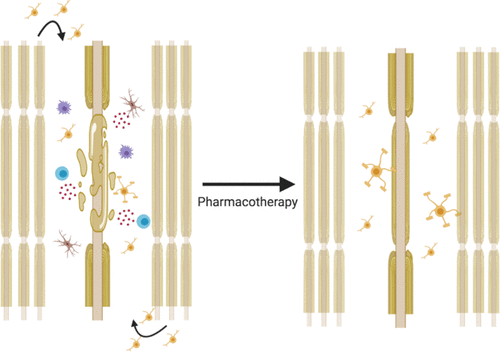当前位置:
X-MOL 学术
›
ACS Pharmacol. Transl. Sci.
›
论文详情
Our official English website, www.x-mol.net, welcomes your
feedback! (Note: you will need to create a separate account there.)
Remyelination Pharmacotherapy Investigations Highlight Diverse Mechanisms Underlying Multiple Sclerosis Progression
ACS Pharmacology & Translational Science ( IF 4.9 ) Pub Date : 2019-11-27 , DOI: 10.1021/acsptsci.9b00068 George S. Melchor 1, 2 , Tahiyana Khan 2 , Joan F. Reger 1 , Jeffrey K. Huang 1, 2
ACS Pharmacology & Translational Science ( IF 4.9 ) Pub Date : 2019-11-27 , DOI: 10.1021/acsptsci.9b00068 George S. Melchor 1, 2 , Tahiyana Khan 2 , Joan F. Reger 1 , Jeffrey K. Huang 1, 2
Affiliation

|
Multiple sclerosis (MS) is an immune-mediated disease of the central nervous system characterized by a complex lesion microenvironment. Although much progress has been made in developing immunomodulatory treatments to reduce myelin damage and delay the progression of MS, there is a paucity in treatment options that address the multiple pathophysiological aspects of the disease. Currently available immune-centered therapies are able to reduce the immune-mediated damage exhibited in MS patients, however, they cannot rescue the eventual failure of remyelination or permanent neuronal damage that occurs as MS progresses. Recent advances have provided a better understanding of remyelination processes, specifically oligodendrocyte lineage cell progression following demyelination. Further there have been new findings highlighting various components of the lesion microenvironment that contribute to myelin repair and restored axonal health. In this review we discuss the complexities of myelin repair following immune-mediated damage in the CNS, the contribution of animal models of MS in providing insight on OL progression and myelin repair, and current and potential remyelination-centered therapeutic targets. As remyelination therapies continue to progress into clinical trials, we consider a dual approach targeting the inflammatory microenvironment and intrinsic remyelination mechanisms to be optimal in aiding MS patients.
中文翻译:

髓鞘再生药物治疗研究突出了多发性硬化进展基础的多种机制。
多发性硬化症(MS)是中枢神经系统的一种免疫介导的疾病,其特征是复杂的病变微环境。尽管在开发免疫调节疗法以减少髓磷脂损伤并延缓MS进展方面已经取得了很大进展,但是针对该疾病的多种病理生理学方面的治疗选择却很少。当前可用的以免疫为中心的疗法能够减轻MS患者表现出的免疫介导的损伤,但是,它们无法挽救随着MS的发展而发生的髓鞘再生或永久性神经元损伤的最终失败。最近的进展提供了对髓鞘再生过程,特别是脱髓鞘后少突胶质细胞谱系细胞进展的更好的理解。此外,有新发现突出了病变微环境的各种成分,这些成分有助于髓磷脂的修复和轴突健康的恢复。在这篇综述中,我们讨论了中枢神经系统中免疫介导的损伤后髓鞘修复的复杂性,MS动物模型在提供有关OL进展和髓鞘修复的见解以及当前和潜在的以髓鞘为中心的治疗靶点方面的贡献。随着髓鞘再生疗法继续进入临床试验,我们认为针对炎症性微环境和内在髓鞘再生机制的双重治疗方法最适合于MS患者。MS动物模型对OL进展和髓鞘修复以及当前和潜在以髓鞘为中心的治疗靶点的洞察力的贡献。随着髓鞘再生疗法继续进入临床试验,我们认为针对炎症性微环境和内在髓鞘再生机制的双重治疗方法最适合于MS患者。MS动物模型对OL进展和髓鞘修复以及当前和潜在以髓鞘为中心的治疗靶点的洞察力的贡献。随着髓鞘再生疗法继续进入临床试验,我们认为针对炎症性微环境和内在髓鞘再生机制的双重治疗方法最适合于MS患者。
更新日期:2019-11-28
中文翻译:

髓鞘再生药物治疗研究突出了多发性硬化进展基础的多种机制。
多发性硬化症(MS)是中枢神经系统的一种免疫介导的疾病,其特征是复杂的病变微环境。尽管在开发免疫调节疗法以减少髓磷脂损伤并延缓MS进展方面已经取得了很大进展,但是针对该疾病的多种病理生理学方面的治疗选择却很少。当前可用的以免疫为中心的疗法能够减轻MS患者表现出的免疫介导的损伤,但是,它们无法挽救随着MS的发展而发生的髓鞘再生或永久性神经元损伤的最终失败。最近的进展提供了对髓鞘再生过程,特别是脱髓鞘后少突胶质细胞谱系细胞进展的更好的理解。此外,有新发现突出了病变微环境的各种成分,这些成分有助于髓磷脂的修复和轴突健康的恢复。在这篇综述中,我们讨论了中枢神经系统中免疫介导的损伤后髓鞘修复的复杂性,MS动物模型在提供有关OL进展和髓鞘修复的见解以及当前和潜在的以髓鞘为中心的治疗靶点方面的贡献。随着髓鞘再生疗法继续进入临床试验,我们认为针对炎症性微环境和内在髓鞘再生机制的双重治疗方法最适合于MS患者。MS动物模型对OL进展和髓鞘修复以及当前和潜在以髓鞘为中心的治疗靶点的洞察力的贡献。随着髓鞘再生疗法继续进入临床试验,我们认为针对炎症性微环境和内在髓鞘再生机制的双重治疗方法最适合于MS患者。MS动物模型对OL进展和髓鞘修复以及当前和潜在以髓鞘为中心的治疗靶点的洞察力的贡献。随着髓鞘再生疗法继续进入临床试验,我们认为针对炎症性微环境和内在髓鞘再生机制的双重治疗方法最适合于MS患者。











































 京公网安备 11010802027423号
京公网安备 11010802027423号